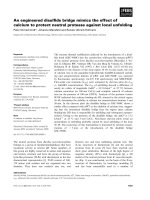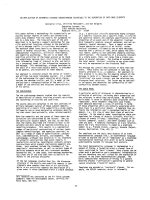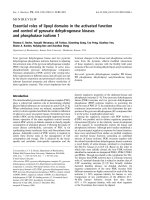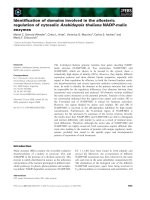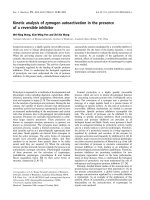Báo cáo khoa học: "An overview of oak silviculture in the United States: the past, present, and future" pdf
Bạn đang xem bản rút gọn của tài liệu. Xem và tải ngay bản đầy đủ của tài liệu tại đây (516.85 KB, 8 trang )
Original
article
An
overview
of
oak
silviculture
in
the
United
States:
the
past,
present,
and
future
R
Rogers
1
PS Johnson
DL
Loftis
1
University
of
Wisconsin,
Stevens
Point,
WI
54481;
2
USDA
Forest
Service,
North
Central
Forest
Experiment
Station,
65211
Columbia,
MO;
3
USDA
Forest
Service,
Southeastern
Forest
Experiment
Station,
Asheville,
NC,
28802
USA
(Received
6
January
1993;
accepted
2
June
1993)
Summary —
Oaks
(Quercus)
are
important
components
of
forest
systems
throughout
the
United
States.
This
overview
describes
past,
present,
and
future
silvicultural
practices
within
the
oak-
hickory
ecosystem
of
the
United
States.
Past
land-use
activities
favored
oak
development,
but
wild-
fire
and
livestock
grazing
controls
have caused
severe
oak
regeneration
problems
that
were
not
recognized
until
recently.Prescriptions
for
weedings,
cleanings
and
the
use
of
stocking
charts
to
con-
trol
intermediate
thinnings
were
early
silvicultural
developments.
More
recently,
growth
and
yield
models
for
managed
stands
were
developed
to
predict
current
and
future
timber
volumes.
Currently,
silviculturists
are
developing
solutions
to
natural
and
artificial
regeneration
problems.
Research
re-
sults
indicate
that,
other
factors
being
equal,
regeneration
success
is
favored
by
simultaneously
re-
ducing
over
and
understory
densities
and
that
oak
seedling
survival
and
development
is
enhanced
in
large
seedlings
that
have
high
root
to
shoot
ratios.
Future
silvicultural
practices
will
have
an
ecosys-
tems
focus.
oak
I
silviculture
I
regeneration
/
thinning
I
model
Résumé —
Un
aperçu
global
de
la
sylviculture
des
chênes
aux
États-Unis :
passé,
présent,
futur.
Aux
États-Unis,
les
chênes
(Quercus)
constituent
partout
des
composants
importants
des
sys-
tèmes
forestiers.
Ce
travail
a
pour
but
de
décrire
les
pratiques
anciennes,
actuelles
et
futures
à
l’in-
térieur
de
l’écosystème
chêne-hickory
des
États-Unis.
Autrefois,
les
activités
réalisées
dans
l’utilisa-
tion
des
terres
favorisaient
le
développement
des
chênes.
Toutefois,
la
lutte
contre
les
incendies
de
forêt
spontanés
et
le
pâturage
du
bétail
a
entraîné
des
problèmes
sévères
pour
la
régénération
des
chênes,
problèmes
non
reconnus
juqu’à
ces
derniers
temps.
Les
prescriptions
pour
le
désherbage,
le
défrichement
et
l’emploi
des
tableaux
de
stockage
pour
contrôler
l’éclaircissement
intermédiaire
de
sylviculture
étaient
des
anciens
développements
en
sylviculture.
Plus
récemment,
on
a
dévelop-
pé
des
modèles
de
croissance
et
de
rendement
pour
les
peuplements
aménagés
afin
de
prévoir
les
volumes
de
bois
actuels
et
futurs.
Actuellement,
les
sylviculteurs
sont
en
train
de
formuler
des
solu-
tions
aux
problèmes
de
régénération
naturelle
et
artificielle.
Les
résultats
des
chercheurs
indiquent,
que,
toutes
choses
égales
d’ailleurs,
le
succès
en
régénération
est
favorisé
par
la
réduction
sponta-
née
de
la
densité
des
voûtes
inférieure
et
supérieure
et
que
la
survie
et
le
développement
des
plants
de
chêne
sont
augmentés
chez
les
grands
semis
qui
ont
un
rapport
racine-pousse
élevé. À
l’avenir,
les
pratiques
de
sylviculture
seront
centrées
sur
les
écosystèmes.
chêne
/ sylviculture
/ régénération
/ éclaircissement
t
/ modèles
INTRODUCTION
The
International
Union
of
Forestry
Re-
search
Organizations
(IUFRO)
held
its
100th
anniversary
meeting
during
the
peri-
od
31
August
to
4
September,
1992
at
the
IUFRO
birthplace
in
Eberswalde,
Ger-
many.
The
theme
of
this
meeting
revolved
around
where
we
have
been,
where
we
are,
and
where
we
are
going
in
forestry
re-
search.
The
paper
presented
here
is
based
on a
talk
delivered
at
this
special
meeting.
Time
and
space
limitations
necessarily
forced
us
to
define
more
narrowly
the
scope
of
the
topic
of
oak
silviculture
in
the
United
States.
Hence,
the
material
here
should
not
be viewed
as
a
comprehensive
treatment
of
the
subject,
but
rather
as
a
document
that
highlights
certain
events
that
we
believe
are
important.
DISCUSSION
Forestry
in
the
United
States
had
its
begin-
nings
about
the
time
that
IUFRO
was
founded
in
1892.
Although
the
American
Forestry
Association
was
founded
in
1875
in
order
to
educate
people
about
the
need
for
forest
conservation
measures,
the
con-
servation
movement
in
the
United States
became
a
reality
when
our
national
forest
system
was
started
in
1891,
just
a
year
be-
fore
IUFRO
came
into
being.
However,
scientific
forestry
in
the
United States
was
not
introduced
until
after
the
turn
of
the
century
when
the
US
Forest
Service
was
established
in
1905
and
IUFRO
was
al-
ready
13
yr
old.
We
owe
our
forestry
ori-
gins
to
Europe
because
it
was
European
methodology
that
was
transplanted
to
the
US
by
early
American
foresters
like
Gifford
Pinchot,
the
first
chief
forester
of
the
US
Forest
Service.
Early
forestry
programs
in
the United
States
focused
primarily
on
protectionist
activities
such
as
wildfire
prevention
and
suppression.
These
activities
extended
to
all
tree
species
and
ecosystems
including
those
containing
oaks
(Quercus).
Oaks
have been
and
currently
are
ex-
tremely
important
components
of
forest
systems
throughout
the
United
States.
They
extend
from
the
northeastern
hard-
wood
forests
bordering
the
Atlantic
Ocean
to
the
western
hardwood
rangelands
of
California,
Oregon,
and
Washington
and
from
the northern
mixed
conifer
forests
of
the
Great
Lakes
and
Canada
southward
to
the
bottomland
hardwood
and
southern
yellow pine
woodlands
that
adjoin
the
Gulf
of
Mexico.
Although
oaks
are
widespread,
they
predominate
in
central
and
eastern
United
States
forest
and
form
the
upland
and
bot-
tomland
oak
ecosystems.
Together,
these
ecosystems
encompass
≈ 114
million
acres
and
provide
a
habitat
for >
75
tree
species,
230
species
of
birds
and
mam-
mals,
plus
numerous
other
plants
and
ani-
mals.
This
covers
an
area
which
is
=
30%
larger
than
all
of
Germany.
Generalizing
about
oak
silviculture
over
time
and
space
is
difficult
because
there
are
many
oaks
that
grow
under
a
wide
range
of
conditions.
Nevertheless,
by
fo-
cusing
attention
on
the
upland
regions
of
eastern
oak
ecosystems,
we
can
make
several
universal
statements
about
early
silvicultural
practices
and
how
those
prac-
tices
have
evolved
to
address
current
silvi-
cultural
problems,
and
how
they
may
be
modified
and
used
in
the
future.
Usually
forest
resource
managers
adopt
or
modify
silvicultural
practices
after
con-
sidering
both
natural
and
social
forces
that
act
upon
the
forest.
Our
current
oak
forest
were
shaped
by
presettlement
and
early
settlement
activities.
These
activities
fa-
vored
oak
development
by
disrupting
sec-
ondary
succession.
Fires
during
presettle-
ment,
and
land
clearing
combined
with
fre-
quent
fires
and
grazing
by
cattle
during
settlement
times
gradually
eliminated
com-
peting
species
or
deterred
their
develop-
ment
(Lorimer,
1989;
Abrams,
1992).
Oaks
became
more
important
just
prior
to
and
during
the
1930s
as
a
consequence
of
the
demise
of
the
American
chestnut
(Castenea
dentata)
due
to
chestnut
blight
(Endothia
parasitica).
During
this
time,
85%
of
the
eastern
upland
oak
forest
con-
tained
oak.
These
forests
were
mostly
sec-
ond-growth
stands
of
sprout
origin.
Despite
the
high
percentage
of
oak
in
these
stands,
most
were
understocked,
un-
healthy,
and
in
a
run-down
condition
as
a
result
of
indiscriminate
cutting,
grazing,
fire,
disease,
and
insects
(Schnur,
1937).
Understandably,
early
silvicultural
prac-
tices
were
geared
toward
modifying
stand
density
and
protecting
oak
stands
from
de-
structive
agents
such
as
wildfires
and
graz-
ing.
Paradoxically,
early
protectionist
silvi-
cultural
practices
unwittingly
created
a
regeneration
problem
that
was
not
recog-
nized
until
much
later.
These
past
land-use
activities
and
accompanying
silvicultural
prescriptions
resulted
in
ecologically
unsta-
ble
even-aged
stands
dominated
by
oak.
Early
foresters
like
Luther
Schnur
(1937)
conducted
studies
to
develop
yield,
stand,
and
volume
tables
for
these
even-
aged
upland
oak
forests.
He
found
that
ful-
ly
stocked
oak
stands
of
average
site
quali-
ty
(18
m
tall
at
50
yr)
grow
at
an
annual
rate
of
3.36
m3
per
ha
if
they
are
not
thinned.
During
the
1930s,
silvicultural
activites
were
geared
mainly
toward
providing
ade-
quate
growing
space
for
featured
species,
such
as
oaks,
and
to
ensuring
their
perpet-
uation
in
future
stands.
Notable
treatments
included
weedings
and
cleanings,
and
in-
termediate
thinnings.
Stands
were
regen-
erated
by
conventional
clearcutting,
seed-
tree
and
shelterwood
methods.
Silviculturists
at
that
time
realized
that
merchantable
yield
could
be
influenced
by
manipulating
stand
density.
However,
they
needed
to
determine
which
density
levels
produced
the
greatest
yield
and
further
how
stand
density
levels
affected
tree
quality.
Because
of
the
need
for
this
kind
of
information,
the
US
Forest
Service
ini-
tiated
studies
in
the
late
1940s
to
deter-
mine
the
extent
to
which
density
effected
growth
and
yield
of
oak
in
the
upland
oak
region.
In
this
regard,
tree
stand
density
is
typi-
cally
expressed
by
units
such
as
basal
area
per
unit
area
or
numbers
of
trees
per
unit
area.
While
these
units
provide
objec-
tive
measures
of
stand
density
silvicultur-
ists
soon
realized
they
were
poor
meas-
ures
or
indicators
of
the
extent
to
which
trees
within
the
stand
were
using
space
available
to
them.
Lexan
(1939)
and
Chisman
and
Schu-
macher
(1940)
worked
on
this
problem
and
developed
a
method
called
tree
area
ratio
for
relating
a
tree’s
growing
space
require-
ment
to
its
stem
diameter.
But
it
remained
for
Samuel
Gingrich
(1967)
to
adapt
the
findings
of
these
researchers
by
integrat-
ing
density
measures
and
stand
size
de-
scriptors
with
tree
area
ratio.
Gingrich
used
the
previously
mentioned
oak
growth
and
yield
studies
initiated
in
the
1940s
by
the
US
Forest
Service
to
determine
the
grow-
ing
space
requirements
of
the
upland
oaks.
One
of
the
most
useful
results
of
Gingrich’s
work
was
the
development
of
a
stocking
chart
(fig
1
).
Gingrich’s
stocking
chart
for
upland
oaks
is
a
graph
that
relates
the
amount
of
growing
space
in
a
given
stand
to
a
refer-
ence
stand
that
is
at
average
maximum
density
or
100%
stocked.
The
vertical
axis
shows
basal
area
per
acre
and
the
hori-
zontal axis
shows
the
number
of
trees
per
acre.
Quadratic
mean
stand
diameter,
a
measure
of
stand
size,
and
stocking
ex-
pressed
as
percent
relative
density
are
overlayed
on
the
graph.
This
chart
depicts
the
relation
between
stocking
and
density
and
allowed
us,
for
the
first
time,
to
com-
pare
the
adequacy
of
site
utilization
in
stands
of
different
ages
and
site
qualities.
This
is
possible
because
a
constant
stock-
ing
percent
allocated
tree
area
on
the ba-
sis
of
tree
size.
Stocking
charts
are
rou-
tinely
used
to
evaluate
stand
denstity
in
oak
stands
to
determine
the
need
for
thin-
ning.
In
addition
to
developing
the
stocking
chart,
Gingrich
also
discovered
that
the
greatest
volume
returns
resulted
from
thin-
ning
stands
regularly
at
10-
to
15-yr
inter-
vals
beginning
at
age
10
yr.
He
found
that
such
a
stand
would
at
least
double
the
merchantable
volume
produced
by
a
simi-
lar
but
unthinned
stand
over
the
course
of
a
rotation
on
the
same
site
(Gingrich,
1971
).
This
study
and
others
provided
the
ba-
sis for
constructing
computer
models
dur-
ing
and
following
the
1970’s
that
simulated
growth
and
yield
in
upland
oak
stands
with
and
without
cultural
treatment.
Some
ex-
amples
are
GROAK,
SILVA,
TIMPIS,
COPPICE,
G-HAT,
OAKSIM
and
TWIGS
(Dale,
1972;
Rogers
and
Johnson,
1984;
Hilt,
1985;
Marquis,
1986;
Perkey,
1986;
Shifley,
1987).
With
some
exceptions,
most
oak
cultu-
ral
work
has
focused
on
intermediate
treat-
ments
which
alter
stand
density
and
com-
position
by
thinning.
Less
attention
was
given
to
the
regeneration
phase
of
oak
management.
Traditional
regeneration
techniques
were
relied
upon
to
regenerate
oak
stands
following
stand
removal.
How-
ever,
it
was
not
until
the
1970’s
that
forest-
ers
began
to
realize
the
seriousness
of
the
regeneration
failures
that
were
occurring
thoughout
the
oak
region.
The
scope
of
the
problem
was
not
ap-
preciated
until
methods
were
available
to
evaluate
the
adequacy
of
oak
advance
re-
production
(Sander
et al,
1984).
Subsequently,
silviculturists
learned
that
for
many
oak
ecosystems,
regeneration
success
was
related
to
the
size
and
num-
bers
of
advance
regeneration
(Sander,
1971;
Sander
et
al,
1984).
Past
and
cur-
rent
regeneration
surveys
showed
a
lack
of
adequate
size
and
numbers
of
oak
regen-
eration
with
the
result
that
some
oak
fo-
rests
were
being
displaced
by
more
toler-
ant
species
(Nowacki
et
al,
1990).
The
cumulative
effect
of
this
and
other
factors
like
the
spread
of
oak
wilt,
gypsy
moth,
and
urban
development
has
resulted
in
a
substantial
decline
in
the
areal
importance
of
oak.
Substantial
research
is
currently
under-
way
to
better
understand
natural
regenera-
tion
processes
in
oak
ecosystems.
Such
research
is
called
regeneration
ecology.
However,
generalizing
about
the
problem
of
oak
regeneration
across
species
and
ecosystems
is
difficult
because
of
differ-
ences
in
regeneration
strategy
among
the
oaks.
Seeding,
various
modes
of
sprout-
ing,
and
vegetative
multiplication
represent
different
tactics
that
oaks
employ
in
their
regeneration
strategy.
Although
all
North
American
oaks
rely
to
some
extent
on
both
seeding
and
sprouting,
the
extent
to
which
they
rely
on
one
tactic
over
the
other
dif-
fers
greatly
among
species.
Oak
reproduction
consists
of
seedlings,
seedling
sprouts,
and
stump
sprouts.
When
present
before
a
silvicultural
event
such
as
clearcutting
or
shelterwood
remov-
al,
all
3
growth
forms
are
collectively
termed
advance
reproduction.
All
living
oaks
from
seedlings
to
mature
trees
thus
can
contrib-
ute
to
the
regeneration
potential
of
a
stand.
Oak
regeneration
in
the
drought-
affected
oak
forests
of
the
Missouri
Ozarks
is
largely
dependent
on
sprouting,
and
with
few
exceptions
these
forests
are
seldom
successionally
displaced
by
other
species
(Sander
et al,
1984).
Oaks
of
the
arid
Southwest
may
regen-
erate
almost
exclusively
by
sprouting
from
below-ground
root-like
structures:
ligno-
tubers,
rhizomes,
and
true
roots
(Tiede-
mann
et al,
1987).
Northern
red
oak,
a
mesic
species,
is
flexible
in
its
regeneration
strategy
because
it
can
regenerate
from
seedlings
estab-
lished
after
a
harvest
as
well
as
from
sprouts
from
large
parent
trees
of
advanced
age.
However,
unlike
the
xeric
oak
forests
of
the
Missouri
Ozarks
and
elsewhere,
northern
red
oak
forests
are
frequently
dis-
placed
successionally
by
other
species
(Johnson,
1976;
Lorimer,
1983;
Crow,
1988;
Loftis,
1990a;
Nowacki
et al,
1990).
Seedlings
combined
with
sprouting
is
an
important
regeneration
tactic
of
some
bot-
tomland
oak
species
like
water
oak
and
Nuttall
oak.
However,
bottomland
oak
forests
are
often
displaced
by
other
spe-
cies
because
of
prolonged
periods
with
lit-
tle
or
no
oak
advance
reproduction
due
to
low
seedling
survival
rates
and
infrequent
acorn
crops
(Johnson,
1975;
Johnson
and
Krinard,
1983;
Aust
et al,
1985).
We
are
learning
more
about
the
popula-
tion
dynamics
of
oak
advance
reproduc-
tion.
Several
recent
studies
provide
evi-
dence
that
the
occurrence
of
new
seedlings
is
predictable
only
probabilisti-
cally,
while
seedling
survival
is
more
pre-
dictable
deterministically
because
it
can
be
related
to
stand
and
site
characteristics
such
as
over
and
understory
density,
light,
moisture,
frost
and
predation
by
animals
(Beck
1970;
Loftis,
1988,
1990a;
Crow,
1992).
Successional
replacement
of
oaks
by
oaks
is
heavily
dependent
upon
conditions
that
favor
the
long-term
accumulation
of
oak
reproduction
with
a
high
root
to
shoot
ratio
combined
with
a
large
root
mass
(Johnson,
1979;
Dickson,
1991).
Lacking
those
characteristics,
oaks
are
usually
at
a
competitive
disadvantage.
High
root
to
shoot
ratios
are
obtained
in
oaks
by
recur-
rent
shoot
dieback.
The
accumulation
of
oak
reproduction
under
a
parent
stand
is
one
of
the
most
important
aspects
of
the
regeneration
ecology
of
oaks.
Recurrent
fire
promotes
the
accumula-
tion of
oak
reproduction.
When
fires
are
frequent
and
intense,
oak
savannas
may
result
(Curtis,
1959;
Haney
and
Apfel-
baum,
1990).
But
not
all
oak-dominated
ecosystems
require
fire
or
disturbance
for
their
sustainment.
Many
dry
oak
forests
like
those
in
Missouri
appear
to
be
relative-
ly
stable
communities
and
can
accumulate
oak
reproduction
for
50
or
more
yr
(Sand-
er,
1979).
Such
forests
are
called
auto-
accumulators.
Despite
the
complexity
of
the
oak
regen-
eration
problem,
most
oak
researchers
agree
that
there
is
a
general
relation
be-
tween
site
quality
and
regeneration
suc-
cess:
the
better
the
site,
the
more
difficult
it
is
to
regenerate
oaks
(Arend
and
Scholz,
1969;
Trimble,
1973;
Lorimer,
1989,
Loftis,
1990b).
Although
there
are
no
universal
pre-
scriptions
for
the
regeneration
problem,
we
have
learned
that
modified
shelterwood
systems
increase
both
seedling
survival
and
dominance
probabilities
in
some
oak
forests.
Such
systems
use
a
series
of
par-
tial
cuts
to
reduce
both
canopy
and
sub-
canopy
densities
prior
to
overstory
re-
moval.
Decreasing
the
density
of
both
can-
opy
layers
allows
more
light
to
reach
the
forest
floor
thereby
increasing
both
seed-
ling
survival
and
dominance
probabilities
of
oak
advance
reproduction
and/or
under-
planted
oak
seedlings
(Beck,
1970;
Loftis,
1988,
1990a;
Crow,
1992).
We
have
presented
a
brief
view
of
the
past
and
current
state
of
oak
silviculture
in
the
United
States.
But,
what
does
the
fu-
ture
hold
for
us?
We
will
limit
our
specula-
tions
to
the
next
decade.
We
believe
great
effort
will
be
expended
in
continuing
the
research
in
oak
regeneration
ecology.
Pre-
dictive
regeneration
models
for
oak
eco-
systems
will
be
developed
just
as
various
oak
growth
and
yield
models have
been
developed
over
recent
years.
Such
predic-
tive
models
have
been
particularly
useful
tools
for
the
silviculturist.
However,
these
new
regeneration
mod-
els
will
differ
from
growth
and
yield
models
whose
usefulness
depends
upons
the
cer-
tainty
of
their
predictions.
Rather,
the
new
regeneration
models
will
capture
the
chaotic
regeneration
process
by
modelling
the
probability
of
regeneration
events. For
example,
SIMSEED,
developed
by
Rogers
and
Johnson
(1993)
is
a
probabilistic
simu-
lation
model
of
advance
reproduction
den-
sity
of
northern
red
oak.
Any
given
run
of
the
model
shows
the
pattern
of
the
distri-
bution
of
numbers
of
advance
red
oak
re-
production
under
equilibrium
conditions
(fig
2).
Seedling
survival
and
seedling
input
rates
are
assumed
to
be
intrinsic
to
a
par-
ticular
oak
ecosystem.
The
value
of
the
model
is
not
that
it
will
accurately
predict
the
numbers
of
advance
regeneration
on
the
ground
in
a
given
year,
but
rather
that
it
gives
us
good
information
about
the
like-
lihood
of
observing
such
a
number
in
a
giv-
en
year.
In
certain
respects,
likelihoods
provide
a
better
basis
for
making
forest
management
decisions
than
exact
values.
Such
models
will
be
ecosystem
specific
and
will
be
related
to
ecological
classifica-
tion
systems
currently
being
developed
for
many
of
our
ecosystems.
Forest
managers
will
be
able
to
evaluate
alternative
silvicul-
tural
prescriptions
suggested
by
using
these
models
to
simulate
stand
dynamics
in
specific
oak
ecosystems.
Oak
silvicul-
ture
of
the
future
will
rely
on
maintaining
links
between
observable
responses,
com-
puter
simulation
models,
ecological
classi-
fication
systems,
geographic
information
systems,
and
global
positioning
tech-
nology.
For
the
most
part,
past
oak
silviculture
in
the
United
States
has
focused
on
single
species
and
single
values.
Future
silvicul-
ture
will
deal
with
oaks
as
part
of
an
eco-
logical
unit
capable
of
having
multiple
val-
ues.
Our
improved
understanding
of
eco-
physiological
processes
together
with
the
new
emerging
technologies
mentioned
previously
will
help
us
develop
cultural
sys-
tems
for
managing
communities
of
oak
fo-
rests
to
achieve
general
goals
like
biodi-
versity
and
old
growth
as
well
as
for
prepetuating
specialized
communities
like
oak
savannas.
ACKNOWLEGMENTS
This
paper
was
presented
at
the
Centennial
Meeting
of
the
International
Union
of
Forestry
Organizations
in
Eberswalde/Berlin,
Germany,
in
September
1992.
REFERENCES
Abrams
MD
(1992)
Fire
and
the
development
of
oak
forests.
Bio
Sci 42,
346-353
Arend
JL,
Scholz
HF
(1969)
Oak
forests
of
the
Lake
States
and
their
management.
US
For
Ser Res
Pap
NC
31
Aust
WM,
Hodges
JD,
Johnson
RL
(1985)
The
origin,
growth
and
development
of
natural,
pure,
even-aged
stands
of
bottomland
oak.
In:
3rd
Biennial
Southern
Silvic
Res
Conf
Proceedings
(E
Shoulders,
ed)
US
For Serv
Gen
Tech
Rep
SO
54,
163-170
Beck
DE
(1970)
Effect
of
competition
on
survival
and
height
growth
of
red
oak
seedlings.
US
For
Serv
Res
Pap
SE
56
Chisman
HH,
Schumacher
FX
(1940)
On
the
tree-area
ratio
and
certain
of
its
applications.
J
For 38,
311-317
Crow
TR
(1988)
Reproduction
mode
and
mech-
anisms
for
self-replacement
of
northern
red
oak
(Quercus
rubra)—
a
review.
For
Sci
34,
19-40
Crow
TR
(1992)
Population
dynamics
and
growth
patterns
for
a
cohort
of
northern
red
oak
(Quercus
rubra)
seedlings.
Oecol
Plant
91,
192-200
Curtis
JT
(1959)
The
Vegetation
of
Wisconsin.
Univ
Wisconsin
Press,
Madison,
WI
Dale
ME
(1972)
Growth
and
yield
predictions
for
upland
oak
stands
10
years
after
initial
thin-
ning.
US
For
Serv
Res
Pap
NE 241
Dickson
RE
(1991)
Episodic
growth
and
carbon
physiology
in
northern
red
oak.
In:
Proc
Oak
Res
Upper
Midwest
(SB
Laursen,
JF
Deboe,
eds)
Minn
Ext
Serv
Publi
NR-BU
5663-S,
117-124
Gingrich
SF
(1967)
Measuring
and
evaluating
stocking
and
stand
density
in
upland
hard-
wood
forest
in
the
central
states.
For
Sci 13,
38-52
Gingrich
SF
(1971)
Management
of
young
and
intermediate
stands
of
upland
hardwoods.
US
For Serv
Res
Pap
NE
195
Haney
A,
Apfelbaum
SI
(1990)
Structure
and
dy-
namics
of
midwest
oak
savanna.
In:
Proc
Manage
Dyn
Ecosystems
(JM
Sweeney
ed)
N
Central
Sect
Wildl
Soc,
19-30
Hilt
DE
(1985)
OAKSIM:
an
individual-tree
growth
and
yield
simulator
for
managed,
even-aged,
upland
oak
stands.
US
For
Serv
Res
Pap
NE
562
Johnson
PS
(1975)
Growth
and
structural
devel-
opment
of
red
oak
sprout
clumps.
For
Sci
21,
413-418
Johnson
PS
(1976)
Modal
development
of
re-
generation
in
clearcut
red
oak
stands
in
the
Driftless
Area.
In:
Central
Hardwood
For
Conf/Proc
(JS
Fralish,
GT
Weaver,
RC
Schlesinger,
eds)
S
ILI
Univ,
455-475
Johnson
PS
(1979)
Shoot
elongation
of
black
oak
and
white
oak
sprouts.
Can
J For
Res
9,
489-494
Johnson
PS,
Rogers
R
(1984)
Predicting
25th-
year
diameters
of
thinned
stump
sprouts
of
northern
red
oak.
J
For
82,
616-619
Johnson
RL,
Krinard
RM
(1983)
Regeneration
in
small
and
large
sawtimber
sweetgum-red
oak
stands
following
selection
and
seed
tree
har-
vest:
23-year
results.
Sout J Appl
For
7,
176-
184
Lexen
B
(1939)
Space
requirements
of
pondero-
sa
pine
by
tree
diameter.
US
For
Serv
Res
Note
PSW 63
Loftis
DL
(1988)
Regenerating
oaks
on
high-
quality
sites,
and
update.
In:
Proc
Guidelines
Regen
Appalachain
Hardwood
Stands
(HC
Smith,
AW
Arlyn,
WE
Kidd
Jr,
eds)
Soc
Am
For
Publi
88-03,
199-209
Loftis
DL
(1990a)
Predicting
post-harvest
perfor-
mance
of
advance
red
oak
reproduction
in
the
southern
Appalachians.
For Sci 36,
908-916
Loftis
DL
(1990b)
A
shelterwood
method
for
re-
generating
red
oak
in
the
southern
Appala-
chians.
For Sci 36, 917-929
Lorimer
CG
(1983)
Eighty-year
development
of
northern
red
oak
after
partial
cutting
in
a
mixed-species
Wisconsin
forest.
For
Sci
29,
371-383
Lorimer
CG
(1989)
The
oak
regeneration
prob-
lem:
new
evidence
on
causes
and
possible
solutions.
Univ
Wisconsin
For
Res
Anal.
Madison,
WI,
No
8
Marquis
DA
(1986)
SILVAH:
a
stand
analysis,
prescription
and
management
simulator
pro-
gram
for
hardwood
stands
in
the
Alleghen-
ies. In:
For
Microcomp
Software
Symp
1986,
June
29-July
2,
Morgantown,
WV
(HV
Wi-
ant,
DO
Yandel,
WE
Kidd,
eds)
W
Virginia
Univ,
224-240
Nowacki
GH,
Abrams
MD,
Lorimer
CG
(1990)
Composition,
structure
and
historical
devel-
opment
of
northern
red
oak
stands
along
an
edaphic
gradient
in
north-central
Wisconsin.
For
Sci 36,
276-292
Perkey
A
(1986)
Stand
projection
using
GROAK
and
GROPOP.
In:
For
Microcomp
Software
Symp
1986,
June
29-July
2,
Morgantown,
WV
(HV
Wiant,
DO
Yandel,
WE
Kidd,
eds)
W
Virginia
Univ, 67-69
Rogers
R,
Johnson
PS
(1994)
SIMSEED:
a
sim-
ulator
of
northern
red
oak
advance
reproduc-
tion
density.
US
For
Serv
Res
Pap
NC
(in
press)
Sander
IL
(1971)
Height
growth
a
new
oak
sprouts
depends
on
size
of
advance
repro-
duction.
J
For 69,
809-811
Sander
IL
(1979)
Regenerating
oaks.
In:
Proc
Nat Silvic
Workshop.
US For Serv
212-221
Sander
IL,
Johnson
PS,
Rogers
R
(1984)
Evalu-
ating
oak
advance
reproduction
in
the
Mis-
sour
Ozarks.
US
For
Serv
Res
Pap
NC 251
Schnur
GL
(1937)
Yield,
stand,
and volume
ta-
bles
for
even-aged
upland
oak
forests.
US
For
Serv
Tech
Bull
560
Shifley
SR
(1987)
A
generalized
system
of
mod-
els
forecasting
Central
States
tree
growth.
US
For
Serv
Res
Pap
NC
279
Tiedemann
AR,
Clary
WP,
Barbour
RJ
(1987)
Underground
systems
of
Gambel
oak
(Quer-
cus
gambelii)
in
central
Utah.
Am
J
Bot
74,
1065-1071
Trimble
GR
(1973)
The
regeneration
of
Central
Appalachian
hardwoods
with
emphasis
on
the
effects
of
site
quality
and
harvesting
prac-
tice.
US
For
Serv
Res
Pap
NE
282


